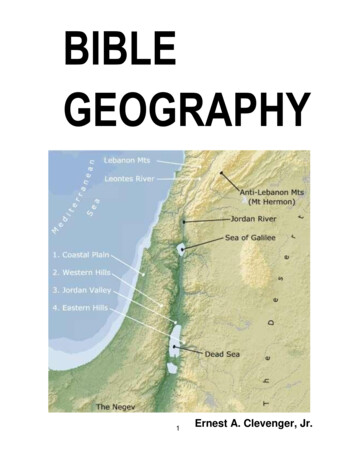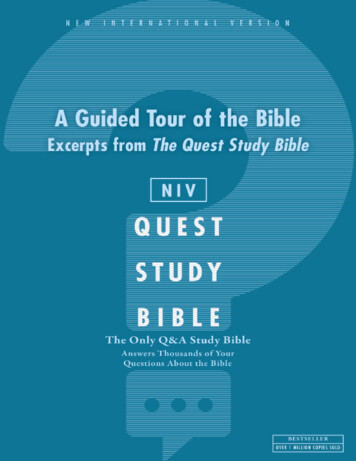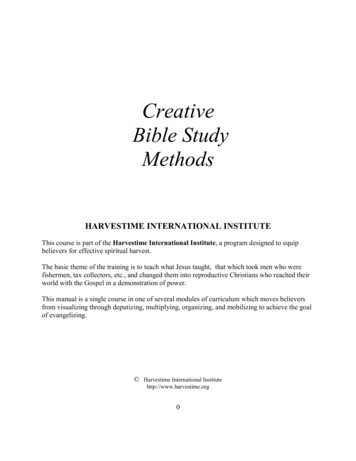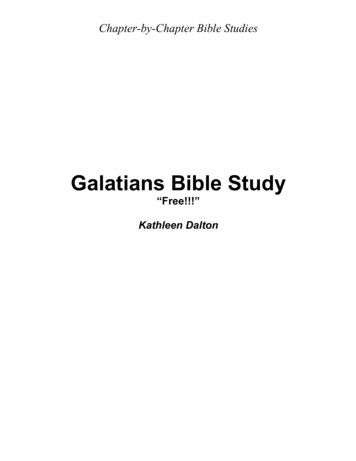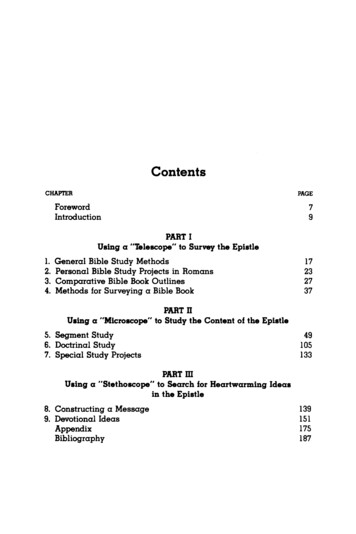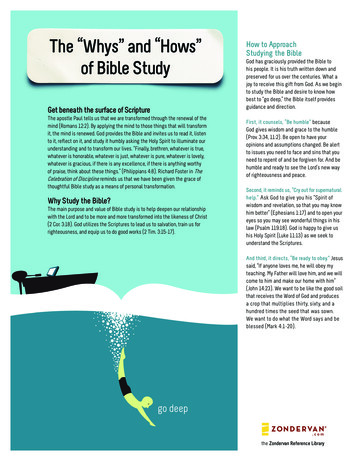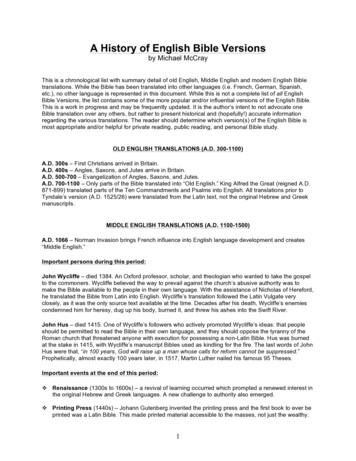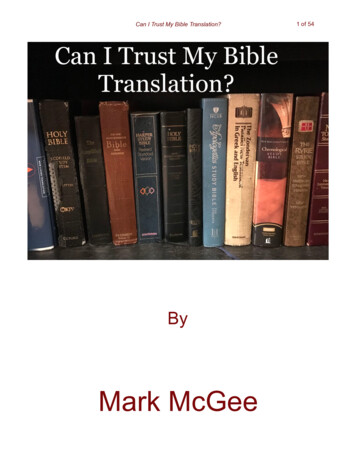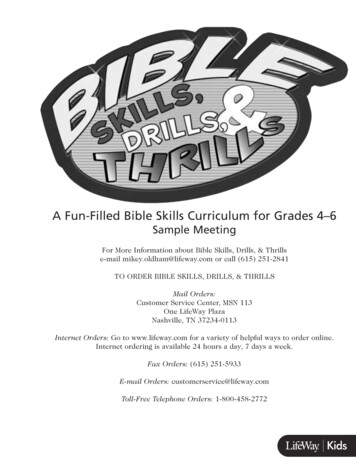
Transcription
How to get the moststudyingyour Bibleout of
observewhatdoIsee?observeEvery time we study the Bible, the first thing to ask is, “What do I see?” Thisis the crucial skill of observation, and it lays the groundwork for the rest of our study.Here are four tasks involved in observation which should be performed in the order below:Obs Task 1: Mark up the passage by visually identifying the followingelements: Underline all verbs. A verb is a word or group of words used to indicate eitherthat an action takes place (“I thank my God”) or that a state or condition exists (“Godis faithful”). Verbs are often the most significant indicators of the author’s flow ofthought. Circle key words or phrases. These are words or short phrases that are importanttheologically (like “word of the cross” in 1:18) or thematically (they set the theme ormain idea for the passage, such as “wisdom” and “foolishness” in 1:18-31). Highlight repeated words or phrases. Include words and phrases that are closelyrelated even if not exact duplicates (such as “judgment” and “judging”). You’ll want tohighlight things that are repeated from previous passages (such as “Now concerning”found in 7:1,25; 8:1; 12:1; 16:1). Box connecting words. These important words indicate the logical connection between words, phrases, and clauses. Here are eight types of common connecting wordsto look for:1. COMPARISON: either points out similarities between two or more related ideas,or simply joins like ideas. Comparison words include: and, like, as, just as, also,so also, even so (e.g. “LIKE a wise master builder I laid a foundation” 3:10).2. CONTRAST: points out dissimilarities between ideas. Contrast words include:but, rather, yet, however (e.g. “Jews ask for signs . BUT we preach Christ crucified” 2:22-23).3. PURPOSE: indicates the intended goal of an idea or action, whether or not it wasrealized. Purpose words include: that, so that, in order that (e.g. ““I have mademyself a slave to all THAT I might win the more” 9:19).4. RESULT: very similar to “purpose,” but indicates the actual consequence, whether or not it was intended. Result words include: that, so that, as a result, with theresult that (e.g. “I baptized none of you except Crispus and Gaius SO THAT noone would say .” 1:14-15).5. CAUSE: expresses the basis or cause of an action. Cause words include: because, since and sometimes for (e.g. “I praise you BECAUSE you remember mein everything” 11:2).2
6. EXPLANATION: what follows further explains the previous idea, giving reasonswhy it is true or why it occurred or simply adding additional information. Look forthe key word for (e.g. “FOR by one Spirit we were all baptized into one body”12:13).7. INFERENCE: provides a logical consequence, a conclusion, or a summary tothe previous discussion. Inference words include: therefore, for this reason (e.g.“FOR THIS REASON I have sent to you Timothy” 4:17).8. CONDITION: presents a condition that must occur before a certain action orconclusion can occur. The statement may or may not reflect reality (i.e. it couldbe hypothetical). Key word is if (e.g. “IF any man’s work which he has built on itremains, he will receive a reward” 3:14).Obs Task 2: List 2-3 primary themesyou see in the passage eachweek.A primary theme is the big idea, the central truth or command that the passagefocuses on, such as “the wisdom of God” and “the Spirit reveals truth” in 1:18-2:16. Afterreading the passage, write your themes as single words or short phrases. Identifying thesethemes at the beginning of your study will help you develop a good overall grasp of thepassage.Obs Task 3: Write two or more observations per verse.Our observations might identify people, places, or events, point out repeated wordsor key terms, record important connections between words and sentences, or even pointout something missing that we expected to see.Obs Task 4: Record your own interpretive questions.Here are a few examples:WHO is.Paul talking about?.accomplishing the action?.benefiting from it?WHAT is the.meaning of this word?.significance of this phrase?.implication of this statement?.relationship between thesephrases?WHY did Paul.choose this word?.include this phrase, statement,or command?.connect these ideas?.not say ?3
interpretwhatdoesitmean?interpretOur observation of a passage should have stirred up interesting yet challengingquestions, leading us to the second stage of our Bible study, interpretation. Fortunately,we do not have to run to a commentary or study Bible for answers (though these are helpful tools to check our conclusions). Use the following six methods, as needed, to tackle avariety of questions, and make sure to familiarize yourself with the three “Principles ofInterpretation” below:PRINCIPLES OF INTERPRETATION:PrinciPle #1 - Your goal is to discern the author’s intended meaning tothe original audience. Unfortunately, most people begin their Bible study by asking,“What does this passage mean to me?” While there may be multiple possible applicationsto my life, there is only one meaning, the author’s intended meaning; and we must firstseek this out. This involves three important steps:1. Always start your study with prayer, asking the same God who composedScripture through these ancient authors to give you insight to understand His intended meaning.2. Be very careful to avoid reading your 21st century circumstances andtheological issues into the text as they will skew our understanding.3. Work diligently to see the text from the point of view of the originalreaders. To do this: [a] dig into the historical and cultural background using Bibledictionaries and commentaries, and [b] spend a few moments thinking about theoriginal audience’s religious understanding by asking - What books of the Bibledid they have access to? What did they know about God? about Jesus? about salvation? etc.PrinciPle #2 - Assume a “normal” use of language. The Bible was given to usbecause God desired to communicate with us, not to hide Himself from us. Therefore,we should not be looking for “hidden” meanings as we study. Instead, we should use the“normal” techniques we would use to understand any piece of literature:1. Study the grammar. Yes, most of us hated grammar in junior high, but it really is helpful for understanding Scripture! So pay attention to nouns, verbs, adjectives, and prepositions. Think through any fi gures of speech. Observe how phrasesand clauses are connected into sentences and how sentences are linked togetherinto paragraphs.2. Remember that chapters came later. When Paul wrote Corinthians or Lukewrote the book of Acts, they wrote single, unifi ed stories without verse or chapterdivisions. These books were meant to be read just like you would read a letter or anovel. So always keep the overall story in mind as you study each passage.4
Principle #3 - Let Scripture interpret Scripture. Since God is unchanginglytruthful and always consistent (Jn 7:17; Heb 3:6; James 1:17), we can, and should, expectthe same of His word. This has two practical applications:1. Check your conclusions. Always compare your conclusions with the teachings of Scripture as a whole. If you fi nd that your interpretation of a passage contradicts the clear teaching of Scripture elsewhere, you probably need to revise yourconclusions.2. Allow clear passages to illuminate ambiguous passages. Whenever youencounter a passage that is confusing or open to multiple possible interpretations,use clearer passages of Scripture to guide you to the correct interpretation.One last caution - remember that God revealed Scripture progressively, not all at once.Therefore, we should not be surprised by differences between how people related to andunderstood God at different times in the history of Scripture. For example, while Abraham needed only believe that God was faithful in order to be justifi ed (Gen 15:6), in theNT era, we must believe in the death, burial, and resurrection of Jesus to be saved (1 Cor15:1-7).Int Method 1: Use the context.Look for important clues in the sentences and paragraphs that come before andafter the verse in question. Try to follow Paul’s flow of thought through the whole chapter.This may take you to the previous lesson, so have it handy as a review. You may need toread ahead in 1 Corinthians for clues.Int Method 2: Compare multiple translations.This packet uses the New American Standard (NASB) translation. You can oftenfind helpful interpretive clues by comparing this translation with other translations. TheNew King James Version (NKJV), like the NASB, is a fairly word-for-word translationof the Greek text. The New International Version (NIV) and the New Revised StandardVersion (NRSV) are excellent phrase-to-phrase translations of the Greek and are thusoften easier to read. Another excellent phrase-to-phrase Bible, which includes extensivetranslation notes, is the New English Translation (NET) available online for free at www.bible.org. You can find and compare numerous translations of any Bible passage at www.biblestudytools.net.Int Method 3: Look up key words.While looking up a key word in English is helpful, doing so in Greek is far betterand is surprisingly easy thanks to the internet. Simply log onto www.biblestudytools.net, and as an example, type in “1 Cor 2” in the “search for:” box, set the “using:” box to“NAS with Strong’s Numbers” and click “Find.” All of 1 Cor 2 will appear on the screenwith most of the words highlighted in blue. Clicking on any of these will bring up a newscreen that will tell you the Greek word used here, its possible definitions, and the totalnumber of times it is used in each book of the New Testament (NT). Click on any of theother NT books (under the title “NAS Verse Count”) and get a display of every verse inthat book that uses this Greek word. To refine your understanding of Paul’s use of a word,look at some of his uses in his other books, such as Romans or Philippians.5
Int Method 4: Study cross-references (Xrefs).XRefs are simply other passages in the Bible that are somehow related to the studypassage. They often prove incredibly helpful as we seek to understand our passage. Youcan find a few XRefs in the margins of most Bibles, but you can find many more by loggingonto another helpful website: net.bible.org. In the top left of the screen under “DisplayBible,” choose “1 Corinthians,” then the chapter you are interested in, and then click “Go.”A new screen will appear with the NET Bible translation of the chapter you requested.Click the “XRef” tab at the top of the screen, and this will take you to an extensive list ofXRefs for every verse in this chapter based on the classic book The Treasury of ScriptureKnowledge. Clicking any of these will bring up the single verse, but you can then click“context” to see the verse in the midst of its surrounding context.Int Method 5: Look up background info.You can find very helpful insights by looking up confusing names or words in a Bible dictionary, or looking up the particular verses you are studying in a background commentary. One of the best dictionaries is The New Bible Dictionary by Wood & Marshall,but you can also find the older Int’l Standard Bible Dictionary [ISBE] online for free (net.bible.org/dictionary.php). The IVP Bible Background Commentary by Craig Keeneris an excellent example of a verse-by-verse background resource.Int Method 6: Tackle tough questions step-by-step.When trying to answer the most challenging questions, follow this four step process. (1) LIST ALL THE OPTIONS. Always start by brainstorming every possible answer to your question. (2) LIST PROS AND CONS FOR EACH OPTION. Seek outall the evidence you can find that either argues for or against a particular option. Thisevidence comes from your study of key words, the grammar of the sentence, the context ofsurrounding verses and the book as a whole, cross references to other books, and comparison with your overall understanding of Christian theology. (3) CHOOSE THE MOSTLIKELY OPTION. Look back at your evidence for each option. Typically, evidence fromthe immediate context is most important, followed closely by evidence from the book as awhole. Evidence from other books or from Christian theology as a whole does not carry asmuch weight unless the solution contradicts a clear passage elsewhere or a major tenantof Christian doctrine. In that case, since Scripture never lies and God can not contradictHimself, you know that solution will not work. (4) DECIDE ON YOUR CERTAINTYLEVEL. Once you have chosen the best solution, step back for a second and humblygauge how certain you are of its accuracy (90% I am very sure this is correct. 60% this solution is just a bit more likely than the others!) Finally, talk with others and checkcommentaries or reference books to see what solutions they have chosen and why.6
applyhowdoesitwork?APPLYOur Bible study is not over until we apply what we have learned to our everydaylives. And lest we underestimate the value of this last step, remember that in God’s eyesit is the person who does not just know His Word, but also obeys His Word that trulyloves Him (see John 14:21). So how do we apply this passage to our lives? Applicationinvolves the following two tasks:App Task 1: List potential principles from your passage.A “principle” is simply a fact or command stated or implied in a particular passagethat is practically relevant to our lives. Legitimate principles are not specific to a particular person (e.g. 1 Tim 5:23 is just for Timothy) nor a particular time (e.g. “do not leaveJerusalem” in Acts 1:4). An example from 1 Cor 2 would be, “We can find true wisdom byreading God’s Word as we rely on His Spirit to help us understand it.” It is often helpfulwhen listing principles to consider the following questions:p Is there something to worship or thank God for?p Is there a promise for me to claim or a truth for me to believe?p Is there something I am convicted about that I need to change or begin doing?p Is there something or someone I need to pray for specifically this week?p Is there any relationship I need to work on?App Task 2: Choose one principle and create a plan to apply it toyour life this week.Once you complete your principle list, prayerfully choose the one principle youmost need to work on (do not just choose the easiest to apply!) If you felt deeply convictedabout one in particular, that is probably the one God is leading you to apply! Once youhave chosen a specific principle, answer these two questions:p What exactly will I do differently this week to apply this principle to my life (bespecific)?p Who, other than the Lord, will I ask to help me follow through with this application?7
digdeeper.Recommended ResourcesBible Study Methods:*The Joy of Discovery by Oletta Waldhelpful, very short booklet on basic inductive Bible study methodsLiving by the Book by Howard Hendricksclassic medium-length guide to Bible study; a helpful supplement to GBC’s Inductive Bible Study notesGreek for the Rest of Us by William D. Mouncemedium length guide that will help those who do not know biblical Greek get the most out of studyingthe NT; includes detailed discussion of basic Greek syntax along with practical guides to key bible studymethods (e.g. Greek word studies, analysis of structural indicators, etc)Bible Dictionaries and Word Study Tools:*The New Bible Dictionary by D. Wood and I. Howard Marshall (3rd edition; 1996)the best single resource for good background articles on key biblical words, places, people, objects, themes,and eventsMounce’s Complete Expository Dictionary of Old and New Testament Words by William D. Mounceprovides in-depth definitions for most of the Greek and Hebrew words found in the Bible. No Greek orHebrew knowledge needed.Bible Commentaries:*The Bible Knowledge Commentary by J. F. Walvoord and R. B. Zuck (1 vol for OT, 1 for NT)best single-volume commentary on either testament from a dispensational perspective; not much depthbut helpful at tracing flow-of-thoughtExpositor’s Bible Commentary: Abridged Edition, Two Volume Set by Kenneth L. Barker and John E.Kohlenberger IIIexcellent two volume commentary on the entire Bible from an evangelical perspective*www.soniclight.comDr. Tom Constable’s Expository Notes are free on this site; basically mini-commentaries on every book ofthe Bible by a DTS professorHelpful Websites:*www.biblestudytools.netfree resource for language study – includes Greek text, strong’s numbers, and many English translations;can do full concordance searches; contains some antiquated commentarieswww.bible.orgNETbible translation as well as articles by many DTS profs on a wide variety of resourcesBible Study Software:*LOGOS Bible Software 3 – Christian Home Library or Bible Study Library at www.logos.comvery powerful electronic Bible study library; these are both upgradeable base versions ( 149 for first, 259 for second that provide fast language study and include many of the resources listed here in searchable electronic form (Interlinear Bibles, Greek concordance, New Bible Dictionary, Bible Knowledge Commentary, Ryrie’s and Enns’ systematic theologies, etc)8
questions, leading us to the second stage of our Bible study, interpretation. Fortunately, we do not have to run to a commentary or study Bible for answers (though these are help-ful tools to check our conclusions). Use the follo
